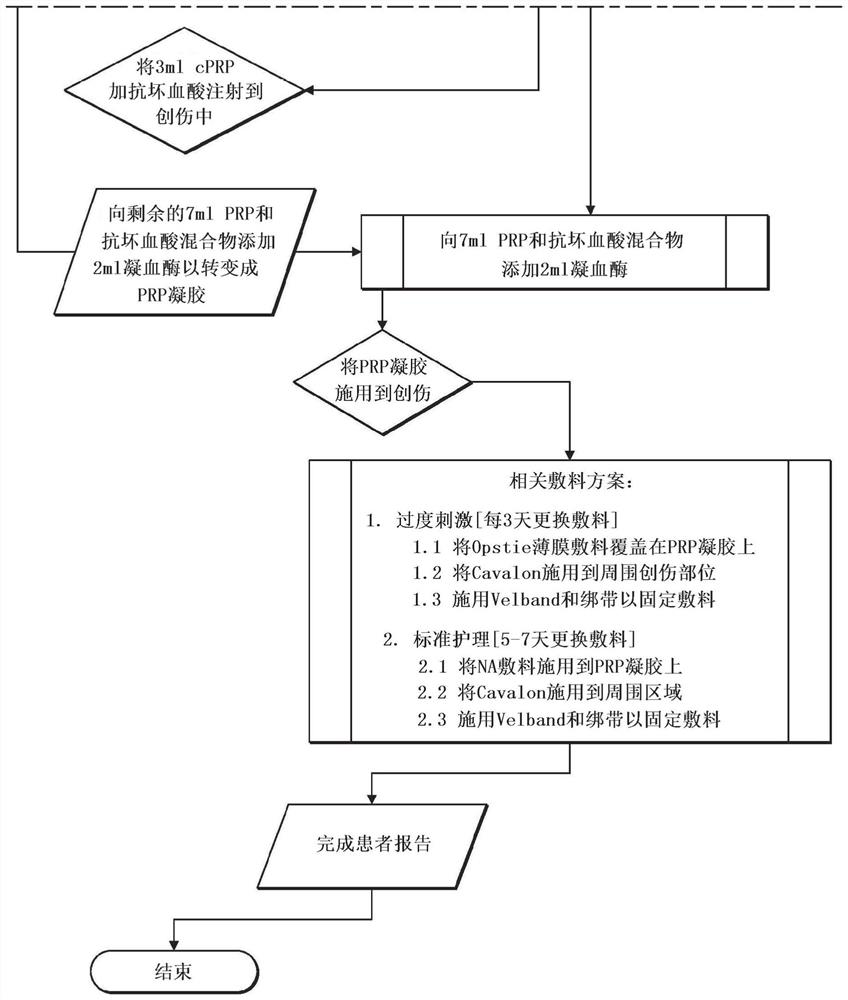Wound treatment gel obtainable by combining platelet rich plasma with autologously derived thrombin
A platelet-rich plasma and thrombin technology, which can be used in liquid delivery, drug combination, blood/immune system cells, etc., and can solve the problems of unapproved use and spread of bovine thrombin
- Summary
- Abstract
- Description
- Claims
- Application Information
AI Technical Summary
Problems solved by technology
Method used
Image
Examples
Embodiment 1
[0081] The following examples outline steps to be taken in the treatment of wounds, for example in diabetic patients.
[0082] stage 1
[0083] PRP with a hematocrit level of 8% was produced for the first treatment. The wound is "surgically refreshed" using surgical debridement of necrotic tissue to expose a fresh floor of the acute wound. The wound treatment composition was produced according to the following formulation. The formulation was designed for volume adjustment and the volume was doubled to treat over >7000mm 3 trauma.
[0084] i. 5ml PRP processed from 52mL whole blood. The PRP contains 5-6x the platelet concentration present in the whole blood sample
[0085] ii. Add 0.75mL ascorbic acid 500mg / 5ml USP
[0086] iii. Add 2 mL of autologous thrombin to activate the PRP / ascorbic acid fluid into a gel.
[0087] The first treatment contains concentrated platelets and a large "dose" of white blood cells. This phase may be referred to as hyperstimulation therap...
Embodiment 2
[0096] In a clinical setting, 18 wounds in 15 patients were treated. 5 patients had extensive tissue loss, bone / tendon / cartilage exposure; 3 patients had renal replacement therapy; 4 patients had significant peripheral neuropathy; 4 patients had deep osteomyelitis; severe nutritional deficiency. Average wound volume at start of treatment: 8203.3mm 3 (The range is 141.3-41257.2mm 3 ). Wounds were treated using the methods outlined in Example 1. Average wound volume at completion of PRP treatment: 2783.2mm 3 (The range is 0.5-28809mm 3 ). Mean reduction in wound volume at completion of treatment: 75%. Total days after initiation of PRP treatment until >90% wound healing: 17.9 days (range 6-40 days). One patient required post-treatment surgical intervention, which was referred to major amputation; the remaining patients were discharged without further intervention.
[0097] Figure 4 Examples of patient wounds treated in this study are shown and Table 1 details the redu...
Embodiment 3
[0101] Diabetic patients undergo surgical debridement of trauma and removal of osteomyelitis in the heel area. The wound is then treated with the wound treatment composition of the present invention. Three treatments were performed within 14 days.
[0102]Bending volume decreased by 36581.2mm in said 14 days 3 (-90.7%). The volume change is -417.3mm 3 (-30.8%), indicating an increase in volume as the wound granulates and regenerates tissue to seal the wound. The reduction of wound area is -1051.1mm 2 (-25.8%). Images of wound healing during the treatment are shown in Figure 5 middle.
[0103] The wound treatment composition is produced according to the present invention. The table below demonstrates the effect of performing the conversion of prothrombin to thrombin at temperatures below 15°C on certain key features of wound care therapy.
[0104]
[0105] The platelet, neutrophil and leukocyte concentrations are expressed as multiples of starting levels.
PUM
 Login to View More
Login to View More Abstract
Description
Claims
Application Information
 Login to View More
Login to View More - R&D
- Intellectual Property
- Life Sciences
- Materials
- Tech Scout
- Unparalleled Data Quality
- Higher Quality Content
- 60% Fewer Hallucinations
Browse by: Latest US Patents, China's latest patents, Technical Efficacy Thesaurus, Application Domain, Technology Topic, Popular Technical Reports.
© 2025 PatSnap. All rights reserved.Legal|Privacy policy|Modern Slavery Act Transparency Statement|Sitemap|About US| Contact US: help@patsnap.com



